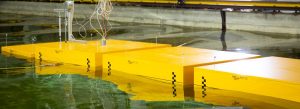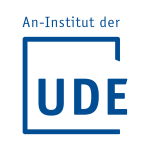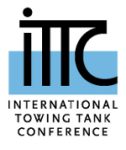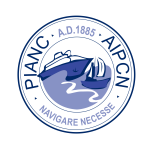For two weeks in January 2020, extensive model testing of the Space@Sea concept took place at DST’s shallow water basin.
The project aims to design multi-use, affordable and standardised floaters that can be assembled to large platforms with arbitrary sizes. Those platforms can serve different functions and applications, e. g. farming applications, living of humans at sea, energy harvesting and for transport & logistic operations.
Photo of the model tests at DST with three main modules in one line and the specific Wave-Energy Converter (WEC) floater (left). A PTO system is mounted between the main and WEC-floater to harvest energy. (Courtesy by Schuman, Daniel).
The test campaign at DST was conducted in the scope of work package 10 that deals with the demonstration and integration of developed subsystems in the work packages 4, 6 and 9. Leading the task 10.3, DST assessed the integrability and compatibility of applications together with the project partners NEMOS GmbH, Technical University of Delft and ICE Pronav Engineering. The assessment was twofold. First it comprises an overarching survey discussing technical requirements of individual generic functions and application specific issues. When individually developed systems are integrated into an entire platform concept, additional challenges are expected and assessed within the survey. In a second step the utilisation of physical models enabled quantitative testing of selected subsystems at the DST and the demonstration of developed strategies at the lab for autonomous ships and vehicles at the TU Delft.
For tests with different configurations of Space@Sea, physical models of the floaters were designed and built at a scale of 1:33.58. An optical tracking system measured the motions of individual modules. The two tested subsystems are the rigid module connector developed in work package 4 and the power take off system with an additional smaller floater for wave energy conversion of work package 6. The derived quantities cover relative motions between the bodies as well as forces acting on the rigid connector. It was concluded that the power take-off reaches expected promising efficiencies. The model of the rigid connector has shown to reach limiting strokes although the derived statistical distributions of forces acting on the connector do not challenge the design with respect to strength capacities. The results are used for the validation of numerical simulations as well as input for project partners to improve their designs in upcoming iterations.
Space@Sea is part of EU’s research programme Horizon 2020. Final results are to be expected by November 2020.
For more information and recent news please visit: https://www.spaceatsea-project.eu/about-space-at-sea
Duration: 3 years (until November 2020)
Contact persons at DST:
Dipl.-Ing. Jens Ley
Gerrit Assbrock M.Sc.
This project has received funding from the European Union’s Horizon 2020 research and innovation programme under grant agreement No 774253.





